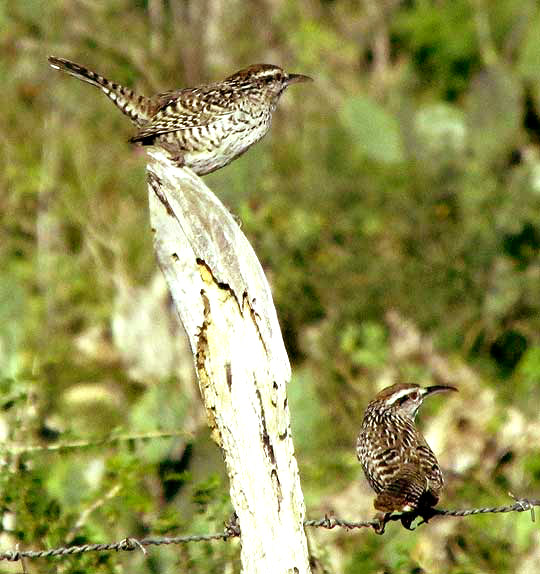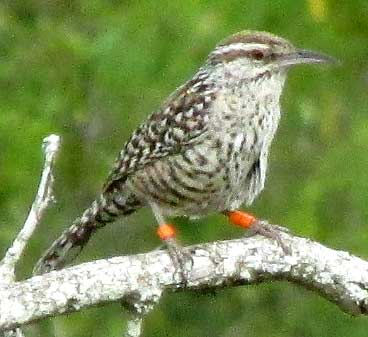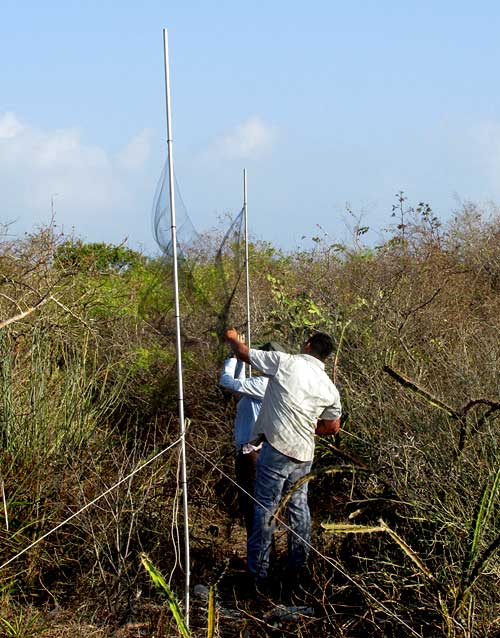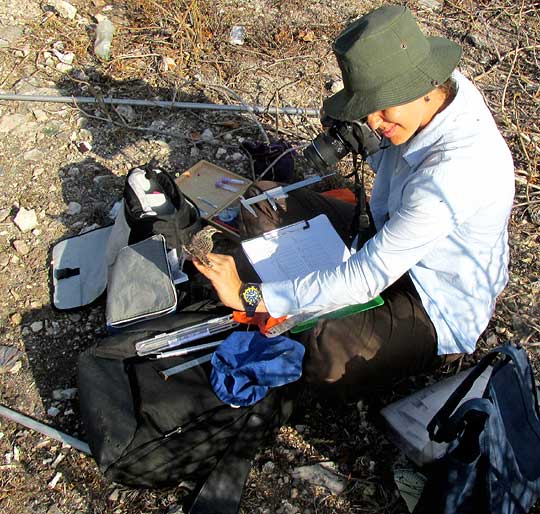Excerpts from Jim Conrad's
Naturalist Newsletter
from the December 7, 2014 Newsletter issued from Río Lagartos, on the Yucatan Peninsula's northern coast (~N21.60°, ~W88.16°), Yucatán state, MÉXICO
YUCATAN WRENS
In the whole world, only in the northern coastal Yucatan Peninsula can you see the bird species shown below:

Those are Yucatan Wrens, CAMPYLORHYNCHUS YUCATANICUS, and they're fairly common along backcountry roads in the ranch/savanna area around here. As you might expect of a wren, Yucatan Wrens are noisy, curious and fairly easy to see. They're closely related to Cactus Wrens of the US southwestern states and arid northern Mexico, which generally are paler on top.
Howell describes the Yucatan Wren's habitat as "arid scrub with cacti, gardens, plantations," and that's exactly what we have here.
from the March 22, 2015 Newsletter issued from Río Lagartos, on the Yucatan Peninsula's northern coast (~N21.60°, ~W88.16°), Yucatán state, MÉXICO
A BANDED YUCATAN WREN
On an inland trip through the thornforest/savanna zone an endemic Yucatan Wren turned up wearing orange leg bands, shown below:

Somebody is clearly studying them here. Diego said folks from Cornell University have been banding in the area.
from the May 17, 2015 Newsletter issued from Río Lagartos, on the Yucatan Peninsula's northern coast (~N21.60°, ~W88.16°), Yucatán state, MÉXICO
BANDING YUCATAN WRENS
On Wednesday a visiting scientist from Cuba, Anay, was in the area capturing and banding Yucatan Wrens. Yucatan Wrens attract researchers because they're so narrowly endemic -- in the whole world found only in a narrow band of arid scrub habitat along the Yucatan Peninsula's northern coast. My friend and student Rayo and I volunteered to help. Below, you can see Rayo and Anay removing a wren from the mist net strung between two poles in the parched, mostly leafless, late-dry-season scrub:

Walking down a little trail through the scrub we'd locate wrens by their distinctive, funny-sounding call, "ch-hor k-k wohrk, eh-hor k-k wohrk... " as Steve Howell interprets it. The net would be erected in any small clearing Anay thought the birds probably were accustomed to flying through, a recording of Yucatan Wrens calling was set going next to the net, we'd step away and watch, and within ten or fifteen minutes normally a couple of birds, presumably a pair, would fly into the hard-to-see net and get entangled. Anay would drop each bird into a bag, carry it to her study spot, and analyze it. Below, you can see Anay at work surrounded by her equipment:

The birds were weighed, and measurements made of several parts, from beak length to toenail length. A feather was removed from each bird's tail and a tiny amount of blood taken for genetic studies to be done later. Since male and female Yucatan Wren's are practically indistinguishable, later each bird's gender would be determined with certainty by looking at chromosomes in the blood samples. Then colored bands were clamped onto the legs.
Once all the measurements and pictures were taken, the birds were released with thanks and good wishes.